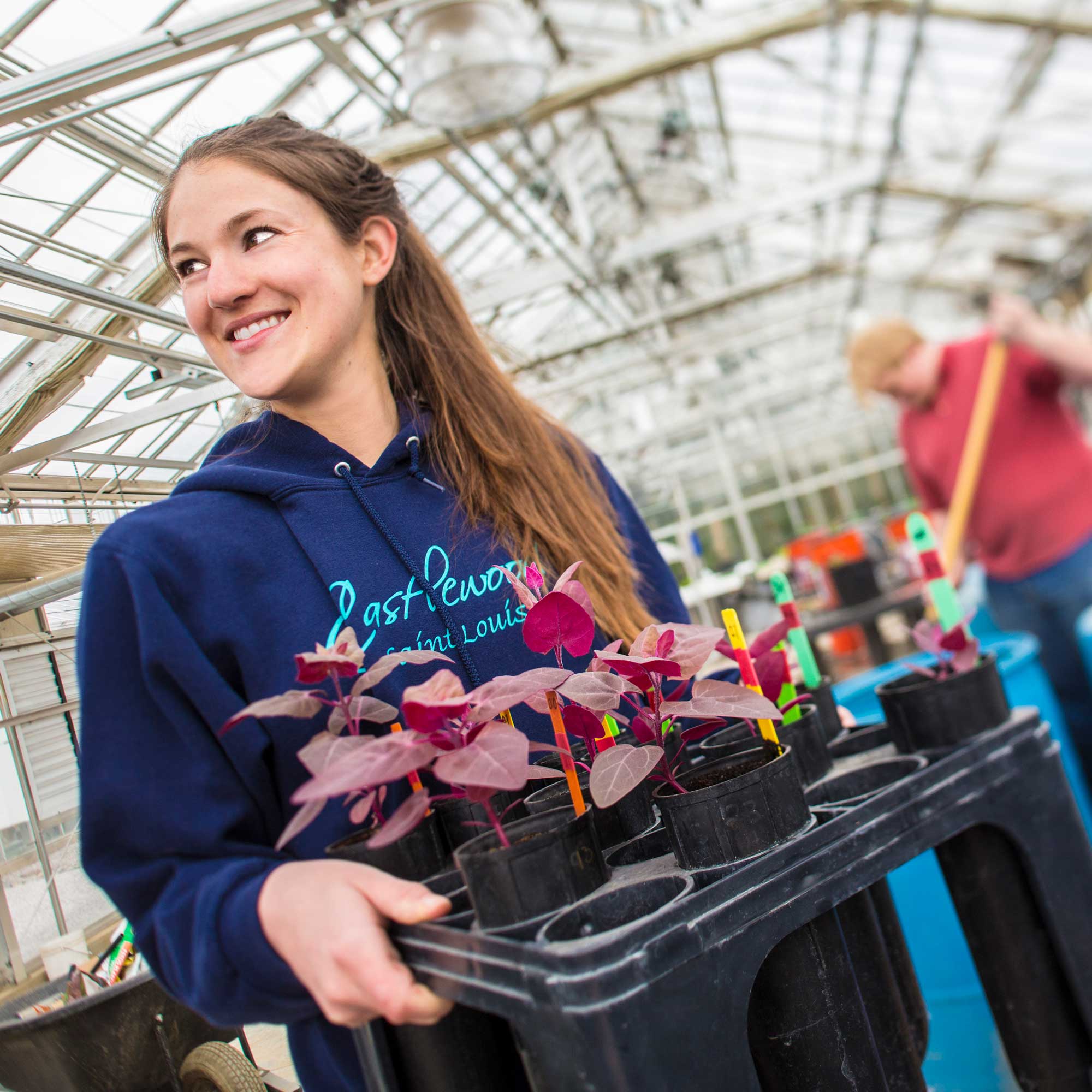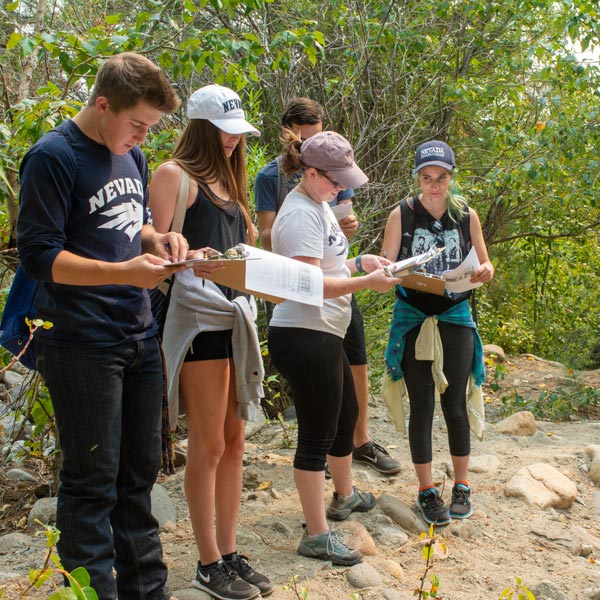In this edition
- Nevadans give feedback on youth education delivery during pandemic
- Food and nutritional toxicology subject of Department of Nutrition course
- Extension's Honey for Heroes Program provides hands-on training for local veterans
- Climate change and suppression tactics are critical factors increasing fires
- University’s Bret Hess supports Experiment Stations across the West
About our College
A founding college of the University, we have a long tradition of excellence in teaching, research and engagement programs that benefit the health and economic vitality of Nevada. We offer programs in:
- agriculture, horticulture, rangeland & veterinary sciences
- biochemistry & molecular biology
- children, youth & families
- community & economic development
- health & nutrition
- natural resources & environmental science
Nevadans give feedback on youth education delivery during pandemic
University publishes youth needs assessment results
Tiffany Kozsan
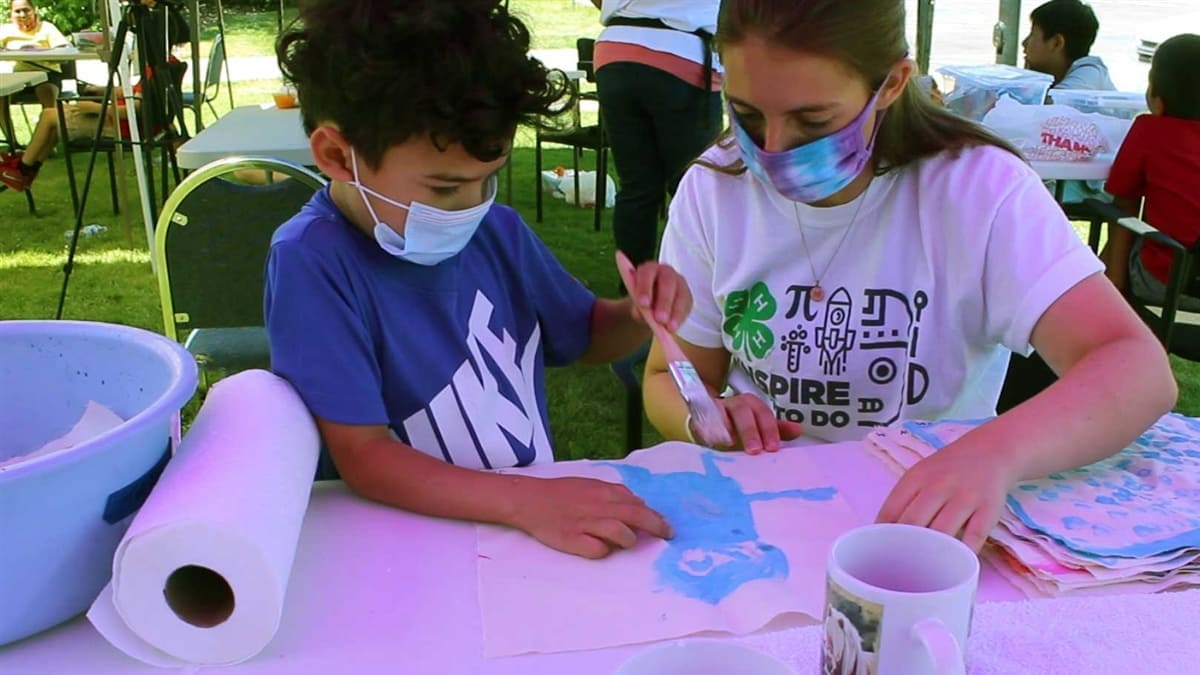 Joseph M., from Washoe County, learns how to do batik, a method of dying cloth using wax and dye, at a 4-H STEAM Day Camp during the COVID-19 pandemic while following all social distancing requirements at the time. Photo by Samantha Shoupe.
Joseph M., from Washoe County, learns how to do batik, a method of dying cloth using wax and dye, at a 4-H STEAM Day Camp during the COVID-19 pandemic while following all social distancing requirements at the time. Photo by Samantha Shoupe.
With the COVID-19 pandemic forcing many children and youth to engage in online learning, there have been concerns about the students’ educational opportunities, mental health and access to resources. According to a statewide survey conducted by the University, communication, quality of distance education, interactive and engaging online learning, and social-emotional health of students were among the most important educational issues of the pandemic.
Of the survey respondents, who were families, school personnel and community members, only:
46%
were satisfied with the school districts’ pandemic response
36%
felt the school year was going good or very good
Individuals from rural school districts responded more positively to both questions than those from urban districts
Extension, a unit of the College, and its 4-H Youth Development Program partnered with the University’s College of Education & Human Development and the Nevada Department of Education to develop and distribute the survey. The survey was created in response to a request from the Nevada Association of Counties.
The survey team plans to collaborate with stakeholders across the state to help address current and future needs to support the education of Nevada’s youth. The team has developed a website where the public can access the initial report and subsequent reports. Families, educators and community members will also find an online resource guide with existing programs and resources that support the academic success and mental health of Nevada youth.
Growing leadership, citizenship and life skills
4-H is a community of young people across America. Members learn life skills, make new friends, enhance self-esteem, achieve personal goals, develop positive relationships with peers and volunteers, and have fun learning and sharing as a family and a club.
Food and nutritional toxicology subject of Department of Nutrition course
Elective has something to offer for students from various majors
Claudene Wharton
 Students in the Food & Nutritional Toxicology course will explore the complexity of chemicals in food, particularly those that have the potential to be harmful.
Students in the Food & Nutritional Toxicology course will explore the complexity of chemicals in food, particularly those that have the potential to be harmful.
The Department of Nutrition is offering Food and Nutritional Toxicology (NUTR 424/624) as an elective this fall. The course will take an in-depth look at toxicants found in foods. Food and nutritional toxicology is the field devoted to studying the chemicals in food, particularly those that have the potential of producing adverse health effects.
Most of us think of food as that which sustains life, and as such, we have the notion that food is an uncomplicated, pure source of essential nutrients. However, food is comprised of an array of chemicals, naturally, and not all of these chemicals enhance nutrient value. In fact, some chemicals decrease the nutritional value or, worse yet, can be toxic. Additionally, some chemicals that are beneficial in smaller amounts become toxic if larger amounts are consumed.
Some of the topics the course will cover include:
- The general principles of toxicology, including methods for food safety assessment and biochemical/physiologic interactions and effects of food toxicants
- The role of environment, genetics and epigenetics (gene expression) in toxicology
- Foodborne intoxications and infections, and consideration of diseases linked to foods
- Prevention of foodborne illnesses
- The regulation of food safety
"This course has something to offer any student who has an interest in food, regardless of their major," said Nutrition Department Chair Jamie Benedict.
For more information, contact Nutrition Professor Stan Omaye, who will teach the course.
Teaching students complex topics
"It’s a complex field. Chemicals in food interact with body fluids and other components of the diet, and it’s those interactions that may have either beneficial or harmful effects." -Nutrition Professor Stan Omaye
Extension's Honey for Heroes Program provides hands-on training for local veterans
Vernon Robison, Moapa Valley Progress
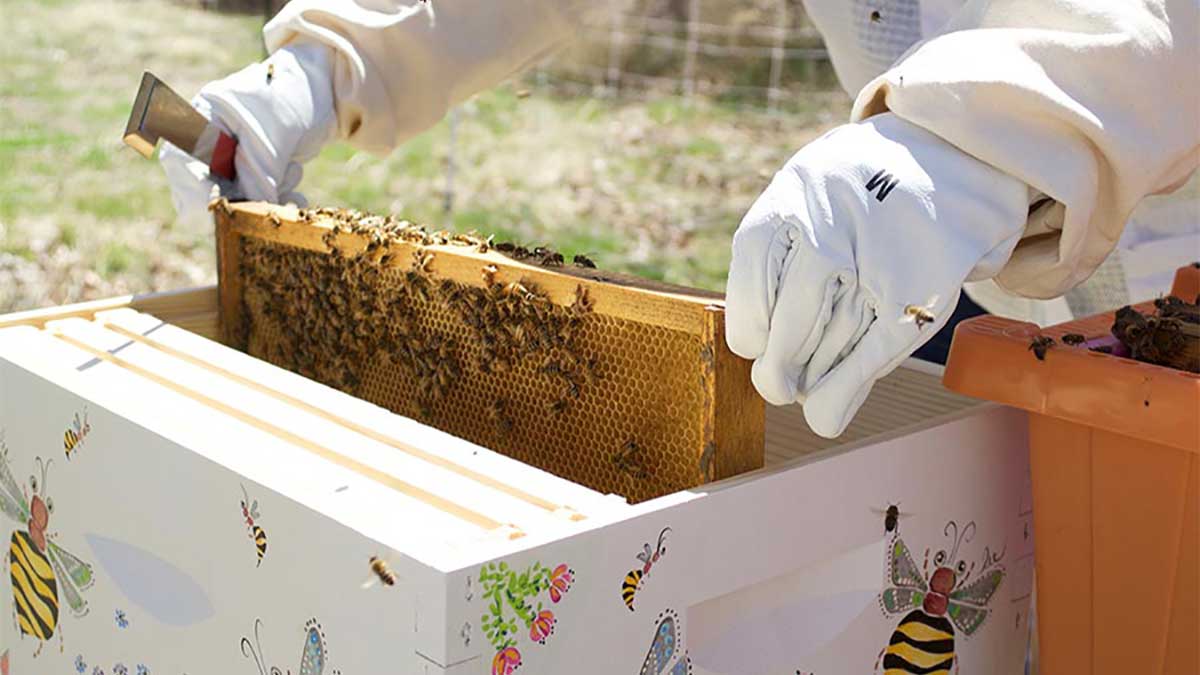 The College's new Honey for Heroes Program joins other beekeeping offerings, including the Douglas County Bee & Pollinator Club (pictured), the Experiment Station's Bees4Vets partnership and a beekeeping education program for southern Nevada. Photo by Kim Steed Photography.
The College's new Honey for Heroes Program joins other beekeeping offerings, including the Douglas County Bee & Pollinator Club (pictured), the Experiment Station's Bees4Vets partnership and a beekeeping education program for southern Nevada. Photo by Kim Steed Photography.
Extension's Clark County office in Logandale is starting a new program which seeks to soothe the nerves of local veterans, while also teaching them a new hobby. The program is called Honey for Heroes. It offers a full hands-on training in the art of beekeeping, completely free, to as many as five local veterans who sign up for the program. The veterans get to keep all of their supplies including beekeeping suits, veils, gloves and all their various tools. Plus each one will be given a hive of bees to work with at home going forward.
Helping veterans and Nevada agriculture
"The program is really good at helping the vets and giving them a lifelong way to deal with their stress. It creates a natural food product which can bring both nutritional and economic benefits. And, the bees pollinate other important plants and trees which produce more food later. It is just a great program." -Extension Educator Carol Bishop
Climate change and suppression tactics are critical factors increasing fires
Integrated research approach shows wildfire solutions must be specific to location and conditions
Erin Hanan and Claudene Wharton
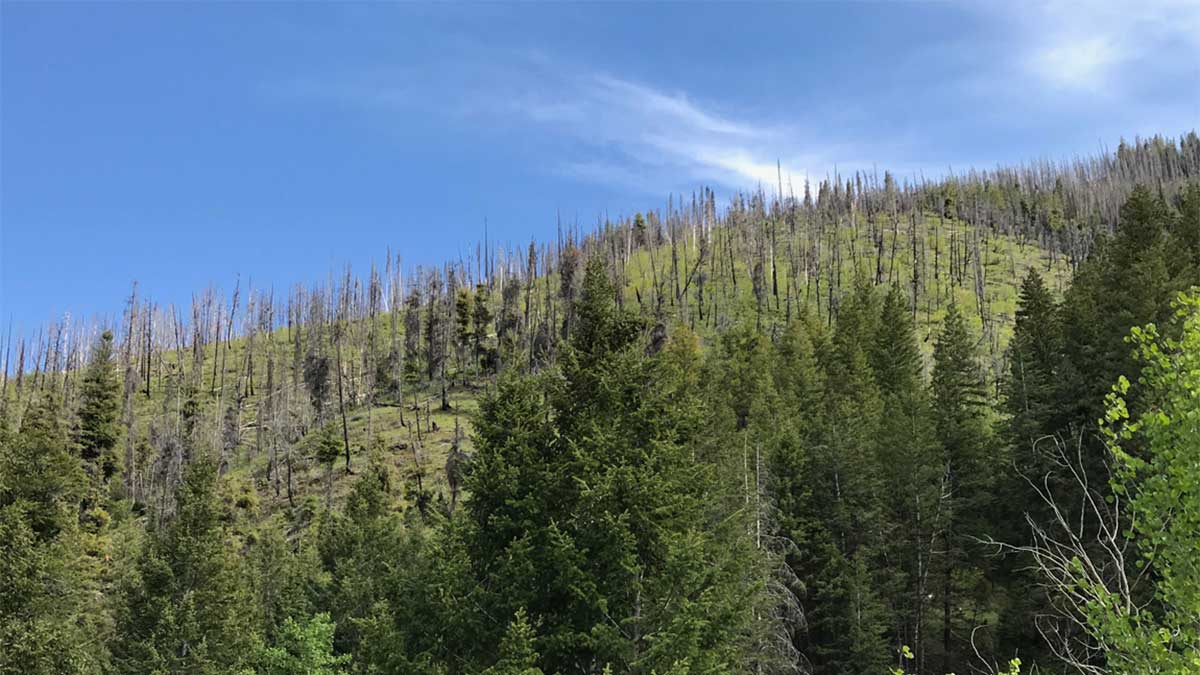 Central Rocky Mountain forest affected by bark beetles and wildfire. Photo by Erin Hanan.
Central Rocky Mountain forest affected by bark beetles and wildfire. Photo by Erin Hanan.
 Lead author Erin Hanan, an Experiment Station researcher and Natural Resources & Environmental Science assistant professor.
Lead author Erin Hanan, an Experiment Station researcher and Natural Resources & Environmental Science assistant professor.The millions of people affected by 2020’s record-breaking and deadly fires can attest to the fact that wildfire hazards are increasing across western North America.
Both climate change and forest management have been blamed, but the relative influence of these drivers is still heavily debated. The results of a recent study show that in some ecosystems, human-caused climate change is the predominant factor; in other places, the trend can also be attributed to a century of fire suppression that has produced dense, unhealthy forests.
Over the past decade, fire scientists have made major progress in understanding climate-fire relationships at large scales, such as across western North America. But a new paper published in the journal Environmental Research Letters details a study that takes this progress to the next level.
The College's Erin Hanan partnered with researchers at four other Western universities to delve into which factors are increasing fire activity at the scales where management actions are implemented, and when and where ecosystems are likely to benefit from fuel management. They looked at data gathered across complex terrain in two mixed-conifer watersheds, in the Idaho Batholith and the Central Rocky Mountains.
Key findings include:
- In one watershed, climate change was the key driver increasing burn probability and the frequency of large fires; in the other, fire suppression dominated in some locations.
- Climate change increased burn probability and led to larger, more frequent fires in locations where soil aridity was relatively low.
- In the most arid locations, climate change promoted drought stress and reduced fine fuel loads, which in turn reduced burn probability.
- In intermediately arid locations, the effects of climate change and fire suppression varied in response to local trade-offs between flammability and fuel loading.
Finding local solutions to the growing wildfire problem
"We found that the effects of climate change and fuels varied at fine scales within watersheds, and the relative influence of these drivers is changing as the climate continues to warm, so solutions to the growing wildfire problem must be adaptive and location-based. That's why it's important to consider local environmental conditions and climate change trends in policy and management planning for the future." -Assistant Professor Erin Hanan
University’s Bret Hess supports Experiment Stations across the West
Hess serves as executive director of the Western Association of Agricultural Experiment Station Directors
Hannah Alfaro
 Bret Hess is working with the College's Experiment Station to host a national meeting at the Squaw Valley Alpine Meadows Resort. Photo courtesy of University of Wyoming’s College of Agriculture and Natural Resources.
Bret Hess is working with the College's Experiment Station to host a national meeting at the Squaw Valley Alpine Meadows Resort. Photo courtesy of University of Wyoming’s College of Agriculture and Natural Resources.Bret Hess, with the College's Experiment Station, has been hired to serve as the executive director of the Western Association of Agriculture Experiment Station Directors, supporting the collective interests of Experiment Stations and agriculture colleges throughout the Western U.S. Additionally, the University was selected to serve as the host institution for the association.
In this role, Hess’s main responsibilities are to provide leadership to Experiment Station directors from the 13 states and four territories making up the association, prioritizing and providing oversight of regional initiatives and multistate projects that include research, Extension and academic programs.
In addition, Hess will collaborate with directors to provide guidance and leadership at the national level for activities through the Experiment Station Committee on Organization and Policy (ESCOP) and as the executive vice chair for the ESCOP Science and Technology Committee.
Hess is also providing support for Chris Pritsos, director of the College's Experiment Station and incoming chair of ESCOP, who will be hosting the Experiment Station Section Annual Meeting in September at the Squaw Valley Alpine Meadows Resort.
Representing local issues on a national stage
"It is great having someone of Bret’s leadership, experience and knowledge joining our Experiment Station family here at the University. I am looking forward to working with Bret during this coming year, as he will help me bring forth issues important to Nevada and the West to the national stage." Experiment Station Director & Associate Dean for Research Chris Pritsos
Growing a stronger Nevada
Our programs work together to make an impact
Our teaching, research and engagement programs are intertwined and complement one another. Faculty who teach on campus also conduct research as part of our Experiment Station, allowing students to learn about and participate in research. Extension faculty engaging with communities identify research needs, as well as join Experiment Station faculty to conduct research. Faculty on campus help to develop Extension programs in communities.
